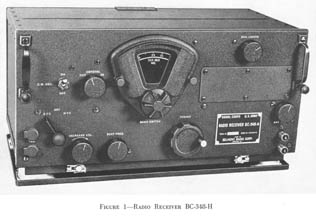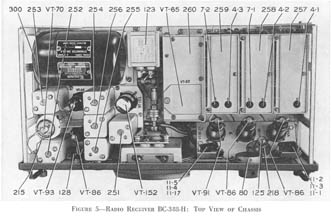BC-348 Page
 This is about the oldest vintage of receiver I deal with. One model of it is populated with metal tubes with grid caps. A real blast from the past. As best I can tell, the design of these receivers dates from the mid-30's. They are a completely classic single-conversion superhetrodyne design. No frills, nothing too fancy. Good, solid, and reliable. Inside, a great deal of the metalwork is either stainless or alluminum, so these receivers rarely show any significant corrosion. Since they are typically 60 or more years old, they are often full of various kinds of insect nests and dust, but nothing more serious than that. Unfortunately, it is rare to find one of these receivers that has not been modified. In fixing up these receivers, I spend much too much time backing out half-baked mods that some yo-yo wired in decades ago. |
BC-348 TidBits
Since these receivers were designed to be powered by dynamotors, most of them you see these days have been converted to use 110VAC (or have a hole where the dynamotor was). There is no particular trick to putting a power supply in. The most annoying part of the conversion is that the filaments were wired in series to operate off of 28 volts DC, so they have to be totally rewired to run in parallel. Luckily they are all 6.3 volt filaments. The real problem is that the receiver is not very tolerant of 60 Hz ripple in the power supply, so great care has to be taken to reduce the supply ripple. This is not a big problem with modern components. I haven't tried making a regulated supply, but it should not be difficult with modern high-voltage FETs. The current draw of these receivers is quite modest, so it does not take much of a power supply to get good operation. |
Scanned BC-348 Manuals
As noted before, one of the most difficult parts of dealing with these old receivers is finding the appropriate manuals. Without schematics and other descriptions, it is a hopeless task trying to repair these things. |
| Download 50MB |
T.O. 08-10-166 "Instruction Book for Operation and Maintenance of Radio Receiver BC-348-S and Radio Receiver BC-224-L" T.O. 8-10-166, dated April 21, 1943. This is a relatively short manual covering these two receivers. Unfortunately, there are some water stains on the pages of this one. |
| Download 117MB |
"Instruction Book for Operation and Maintenance of Radio Receiver BC-348-E, Radio Receiver BC-348-M, Radio Receiver BC-348-P" This manual has a Technical Order number, which is T.O. 08-10-119, dated December 15, 1942. This is one of those extraordinary, beautiful manuals that was printed on glossy paper. I did my best to preserve the detail in the halftone photographs, but it is hard to get all the detail of the originals. There are two 11x17 images at the end - one is the wiring diagram of the manual, which was a fold-out. The other is just a high-resolution scan of the schematics page that has been rotated, magnified and formatted for 11x17 for easy reading. |
| Download 162MB |
"Instruction Book for Radio Receiver BC-348-H. Manufactured by Belmont Radio Corporation, Chicago, Illinois, U.S.A." I couldn't find a date or a Technical Order number on this one. That generally means that it is the preliminary manual written by the manufacturer and issued and used before the military issued their own manual on the radio. This manual is quite complete. It covers the alignment and maintenance of the receiver in some detail. I scanned the schematics at quite high resolution and included them as 11x17 (they were originally 8.5x11 in vertical format) I also include an "annotated" version of the schematics where the part values are shown next to the parts. It makes the schematics a bit busy, but they are much easier to understand. |
| Download 97MB |
"Handbook of Instructions, Radio Receivers BC-224-B, BC-348-B, Radio Corporation of America" T.O. 8-10-25, dated December 20, 1942. This manual looks for all the world like a cheap copy of the BC-348-H manual. The halftone images are nowhere near as crisp as the BC-348-H, and it was not printed on heavy, glossy paper. I did not bother to annotate the schematics, since they are essentially the same. If you downloaded the other one, don't bother with this one (unless, I guess, you happen to have exactly a BC-348-B). |
| Download 136MB |
"Handbook Maintenance Instructions Radio Receivers BC-348-E, BC-348-M, BC-348-O, BC-348-P, BC-348-S, BC-224-E, BC-224-G, BC-224-H, BC-224-L" AN 16-40BC224-3, dated November 13, 1943, revised September 21, 1951!. This is the most recent one I have ever seen. I didn't know they were made this late. The half-tone images in this manual are not great. It was not printed on nice, glossy paper like some of the others. It does seem to be the most complete manual. There are three different sets of schematics and two wiring diagrams. If you can only download one manual, this is probably the one, possibly augmented with one with good half-tone images, like the BC-348-H manual. |
| Download 87MB |
"Instruction Book for Radio Receiver BC-348-J, N, Q" This is a preliminary manual. It is marked as "E.O. 35AB-5BC348-2C." I believe the "E.O." means "Engineering Order." This is before the manual has become a TO (Technical order). I believe this manual became "AN 08-10-112" which was issued February 25, 1942. This manual must predate that one by some amount. I couldn't find a date on it anywhere. The later ones are available below. Note that the J, N, and Q models are the other BC-348 design. It looks just the same from the outside, but as soon as you go inside, you get a surprise. For instance, right on the RF deck, in the place where the first detector (mixer) tube should be, there is an audio output tube(!). Next off, underneath, where the power supply is, there is this great, humongous (sp?) capacitor. It is about a 5" cube! It is all of 8 microFarads at 300 volts - something that would be the size of your little finger now. When restoring one of these, that is the first thing you get rid of . . . it probably leaks anyway. In any case, if you run into one of these radios, you will need this manual. This design doesn't appear in any of the other manuals. You should probably choose one of the "release" versions of the manual listed below, though. |
| Download 77MB |
"Handbook of Maintenance Instructions for Radio Receivers BC-348-J, N, Q" This is also known by it's Air Force designation of AN 08-10-112. This is not the first official printing of the manual, but it is still pretty early. The halftone images are of much better quality (though not as good as the BC-348-H glossy-print manual). |
| Download 76MB |
"Handbook of Maintenance Instructions for Radio Receivers BC-348-J, N, Q" This is also known by it's Air Force designation of AN 08-10-112. This one is the same as the above manual, but it has a number of revisions that were added in December of the same year. The principal revision was the replacement of the parts list. They seem to contain roughly the same information, so I'm not sure quite what the point of the revision was. This one is several pages shorter than the above manual, but I'm not sure if that means that anything is missing, or if the parts list is simply more compact. Again, this is a relatively good printing. |
| Download 31MB |
"Surplus Radio Conversion Manual." There are 3 volumes of these books were written in the years after WWII. A great deal of radio equipment came on the market as military surplus. These manuals were for Ham Radio operators and shortwave enthusiasts who might get hold of some of this equipment. Much of it (like the BC-348) ran on 28 volts DC and had to be modified for 110VAC use. Others required more extensive modifications, such as rewinding coils to change the frequency bands to the Ham bands. This document is not the whole conversion manual, but just the pages relating to the BC-348. This is taken mostly from Volume I (by R.C. Evenson and O.R. Beach) and Volume III (by William I. Orr, of "Radio Handbook" fame). |
| Download 131MB |
"Data Sheets for Tubes used in the BC-348 Series." A number of people have mentioned to me that their tube manuals don't cover the tubes in the BC-348. There are two issues: first is the quaint numbering system the Army used for vacuum tubes, which consists of "VT-" followed by a number (and then sometimes by a letter). Most of these correspond to standard commercial tube types. The second is that some of these tubes date from the 30's and were out of production by the time many tube guides were printed. In this document, I have reproduced (and annotated with the "VT" numbers) the data sheets for all the tubes used in the BC-348 series. These data sheets were scanned from the RCA HB-3 Radiotron Tube Manual. This is a 10-volume loose-leaf set, and is generally considered to be the most complete tube manual that was ever commercially available. I probably overdid the scans, since the tube data sheets don't really need the high-quality reproduction that the manuals themselves require, but I guarantee that every word is as legible as the original (and more so in some cases). |
<
 The J, N, Q models were different. For instance, they have a combined VFO/Mixer stage where they use a single tube that both oscillates and mixes. There is no voltage regulator on the VFO/Mixer tube. On the other hand, they have an extra stage of IF amplification.
The J, N, Q models were different. For instance, they have a combined VFO/Mixer stage where they use a single tube that both oscillates and mixes. There is no voltage regulator on the VFO/Mixer tube. On the other hand, they have an extra stage of IF amplification.